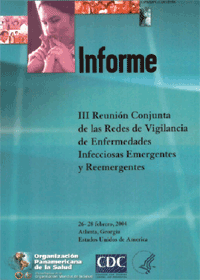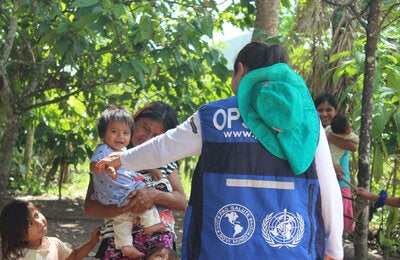(Atlanta, Georgia, USA, 26—28 February 2004)
Executive Summary
As it is customary, the Third Joint Meeting of the Networks for Surveillance of Emerging Infectious Diseases was held in Atlanta, Georgia, USA, from 26 to 28 February 2004, immediately before the International Emerging Infectious Diseases Meeting (2004), so that participants could take advantage of the latter.
 Participants were epidemiologists, laboratory specialists, technical personnel, and/or chiefs of national malaria programs belonging to the emerging and reemerging infectious diseases (EID) surveillance networks. Aside from the Amazon and Southern Cone networks, participants were from the Ministries of Health of Central American countries that constitute the subregion's surveillance network for emerging infectious diseases, as well as representatives from the English speaking Caribbean were invited to participate.
Participants were epidemiologists, laboratory specialists, technical personnel, and/or chiefs of national malaria programs belonging to the emerging and reemerging infectious diseases (EID) surveillance networks. Aside from the Amazon and Southern Cone networks, participants were from the Ministries of Health of Central American countries that constitute the subregion's surveillance network for emerging infectious diseases, as well as representatives from the English speaking Caribbean were invited to participate.
Also attending the meeting were staff in charge of the activities related to communicable diseases from PAHO/WHO offices in Brazil, El Salvador, Guatemala, Honduras, Nicaragua and the Dominican Republic as well as from the Caribbean Epidemiology Center (CAREC). Experts from the Centers for Disease Control and Prevention (CDC), Health Canada, and the US Navy Medical Research Center Detachment (NMRCD) based in Lima, Peru, also participated.
Dr. J.J Amador, Nicaragua, was selected as Chairman, and Drs. D. Enría, Argentina, and P. Rickets, Dominica, as rapporteurs.
The joint meetings of the surveillance networks are essential to share advances and shortcomings, detect needs for improvements, and identify areas of future work and cooperation. The objectives of the meeting were:
-
to present and discuss subregional activities carried out by the EID surveillance networks; and
-
to identify commitments and activities for the period 2004/2005, taking into account the guidelines of the plans of action of each one of them.
The main topics discussed during the meeting included the WHO proposal for the International Health Regulations; preparations for a potential influenza pandemic; the Region's response to SARS; the status of dengue and West Nile virus and of other EID in selected countries. The implementation of syndromic surveillance; and surveillance of antimicrobial resistance and drug resistant Plasmodium falciparum were also discussed. In addition, the degrees of compliance with recommendations issued during the Network's 2003 meetings were reviewed, and new recommendations were made for the period 2004-2005.
The meeting was opened by Dr. J. Hughes of the CDC and by Dr. S. Corber of PAHO. At the opening of the event, reference was made to the current importance and global impact of the local epidemics, and vice versa; the importance of the international regulatory framework (international health regulations) in this regard and its review; the need for evaluating the countries' capacity for detection and response to the emergencies caused by epidemics; and the strengthening of national capacity to these ends.
The following were the main points discussed during the meeting:
With regard to the preparation of plans to deal with the influenza pandemic, the potential economic and social impact on the Region was recognized. North America (CDC and Canada) recounted its experience in the preparation and implementation of preparatory plans for dealing with a pandemic. Chile, representing the Southern Cone countries, described the progress in strengthening epidemiological and virological surveillance and presented the document containing the guidelines for dealing with a pandemic. The other countries were urged to prepare such plans to suit their own realities, taking the existing constraints into account (availability of suitable vaccines and antiviral drugs and equitable access to them). Goals well-adapted to such realities should be established with the object of measuring the impact of the actions.
It was mentioned that the countries with more limited resources might begin strengthening epidemiological surveillance and continue with vaccination activities and the administration of antivirals to selected risk groups. The purchase of vaccines for the annual vaccination campaigns would generate an increase in demand and hence a reduction in costs. The PAHO revolving fund offers an alternative for annual vaccine procurement. It should be taken into account that the financial capacity would not exist for massive purchases in case of a pandemic, and thus, other strategies should also be planned.
With regard to SARS, there were presentations on the experiences of Canada and the United States, the plans developed, and evaluations of the measures adopted. For each of the subregions (Southern Cone, Amazon area, and Central America), described the activities carried out during the global SARS alert. All the countries have prepared plans to deal with the possible introduction of SARS in the Region. Notwithstanding, the SARS experience revealed the vulnerability of the countries with respect to the detection of and response to epidemic emergencies (in the procurement of necessary equipment and supplies, the availability of human resources, the training of multidisciplinary teams for a coordinated response, internal and external communication, and difficulties in laboratory diagnosis, the shipment of samples, and the selection of a suitable test for confirmation). It turns out to be very useful in such circumstances to know the weak points of the system so that its defects can be corrected, as Peru demonstrated in the simulation conducted.
The emergence of West Nile virus, with the detection of the first human cases in Mexico (2003) and circulation of the virus in some of the Caribbean and Central American countries, poses a challenge to the Region. Training workshops have been held for surveillance and diagnosis of this disease with participation of most countries of the Region. The difficulties encountered are related especially to diagnosis (referral of samples and purchase of the necessary reagents) and to the training of multidisciplinary teams, as key elements for coordinated surveillance and response.
With reference to dengue, the need for global surveillance was emphasized, in order to identify trends and forecast potentially risky situations. DengueNet was presented as a tool for global surveillance; its next steps include implementation of the software in a greater number of countries, accompanied by support for the national diagnostic laboratories, and the routine use of the information that the system produces. Several countries have shown deterioration of the epidemiological situation for dengue and dengue hemorrhagic fever. In order to improve the situation, Technical Groups have been set up to cooperate with the countries to jointly develop a national integrated strategy for dengue prevention and control. Such strategy must take into account patient care, social communication, entomological and laboratory aspects, and epidemiological surveillance, as well as any other factor that may influence the epidemiology of dengue.
Several countries presented their experiences in detection and response to epidemiological emergencies. Many of them using syndromic surveillance as a framework for early detection of etiologic agents. This type of surveillance has helped to improve sensitivity in the detection of diseases and etiological diagnosis in several countries of the subregions. The following difficulties were mentioned:
-
the limited capacity of the reference laboratories for differential diagnosis;
-
the need to establish criteria for selecting sentinel posts that ensure the use of representative population for the detection of diseases or etiologic agents;
-
the need to determine the timing for this type of surveillance, based on the epidemiological situation and priorities of the country; and
-
that this type of surveillance should be coordinated and integrated with existing surveillance activities to prevent overlapping of activities.
The current malaria situation in the Region of the Americas was presented; the trend is downward. Nevertheless, malaria continues to pose a threat in the Region due to the growing resistance to malaria drugs, which calls for the development of harmonized, integrated policies in the subregions to achieve standard systems of management. The overall strategy for malaria control advocates timely diagnosis and treatment, with plans of action in the event resistance appears. In this regard, securing greater cooperation among the countries of the different networks is key to information exchange.
The importance of promoting the rational use of antibiotics to prevent resistance from developing was emphasized with the presentation of results of surveillance of antimicrobial resistance in community and hospital isolates. The importance of surveillance of nosocomial infections as an indicator of the quality of care in hospitals was also pointed out as well as the burden that costs of hospital infections represent for the health care system. The need for quality assurance was also stressed, so that there is confidence in the laboratory results.
The last day of the meeting was devoted to evaluating the fulfillment of the commitments assumed by the countries and cooperating agencies at the previous meeting for each of the networks and to stating the new challenges. In introducing the plenary session, the Director of PAHO, Dr. Mirta Roses, thanked Drs. J. Hughes and J. Leduc, from CDC, for their efforts to set up the networks, and noted the importance of the commitment made by the countries and PAHO for continuous improvement of the technical and scientific quality in the surveillance and investigation of EID. With regard to future challenges to creating a safer and healthier Region, she stated that the EID surveillance networks must continue their efforts along these lines.



